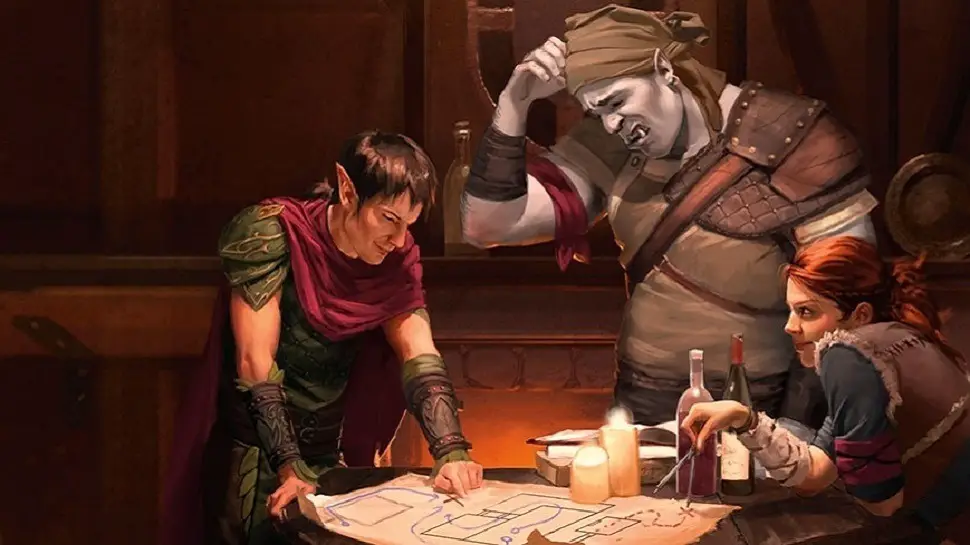Ready Actions are a great way to get an edge on your enemies in D&D 5e.
They allow you to take quick actions outside of your turn, which can be crucial in a fight. Unfortunately, they also tend to cause a lot of confusion for D&D players and DMs alike!
In this article, we will explain everything you need to know about the Ready Action in D&D 5e. We’ll cover how they work, look at their limitations, and answer some frequently asked questions.
Ready Actions are a powerful tool in any adventurer’s arsenal. This guide will make sure you’re using them to your advantage!
What is the Ready Action in D&D 5e?
Sooner or later, it’s bound to happen: you want to do something epic, but things in the initiative order just haven’t quite added up right.
Maybe you’re wanting to throw a Fireball at a group of enemies, but you don’t want to burn your poor Bard to a crisp in the process.
Or maybe that pesky Harpy you’re fighting has flown out of your reach. With no ranged weapons, you’re finding yourself just standing there waiting for her to swoop back down.
The Ready Action is a tactical option that lets you take an action as soon as a specified event occurs. This can happen on a different character’s turn and uses your reaction.
Additionally, knowing how to use the Ready Action is incredibly important if you’re trying to ambush enemies to take them by surprise.

Using the Ready Action
Using the Ready Action is pretty straightforward. The various situations and implications are where it tends to get confusing, but let’s first cover the basics.
First, you declare what action you would like to hold and what trigger will set it off.
Think of this in terms of “If: Then” statements or, more accurately, “When: Then” statements. You need to be specific about both the trigger and the action to be taken.
Consider the examples mentioned earlier and how you might use the Ready Action in those situations.
- “WHEN the Bard moves safely out of the blast range, THEN I will launch a Fireball at the group of orcs.”
- “IF the Harpy comes back within my reach, THEN I will swing with my greataxe.”
If you’re trying to ambush enemies or catch them in a trap, your Ready Action might go something like:
- “WHEN the enemy convoy reaches a specific spot, THEN I’ll give the signal for everyone to open the floodgates.”
- (In this case, other characters would likely be in position with a Ready Action of their own. “WHEN the signal is given, THEN we’ll open the floodgates to wash away the enemy convoy.”)
- “IF the Guard enters my range on his patrol, THEN I’ll leap out of the shadows and get him with a Sneak Attack!”
When the trigger that you declared happens, you can either take your Readied Action right after the trigger finishes or ignore it.
We’ll cover canceling a Readied Action later in this article.
What Actions Can You Ready?
You’ve got plenty of options for what you are able to use the Ready Action on in D&D 5e.
Specifically, you can Ready Action to:
- Make an Attack
- Cast a spell
- Interact with an object
- Move (Dash)
- Help an ally
There’s actually a famous/infamous thought experiment in D&D that relies on exploiting the Ready Action. It’s called the Peasant Railgun and it’s just as insane as it sounds.
If you want a good laugh, you can check out my article about the Peasant Railgun here.

How Long Can You Ready an Action?
When you Ready an Action in D&D 5e, it lasts until the start of your next turn. You’re effectively saying that “if *specific trigger* happens within the next 6 seconds, I will *specific action*.”
This is the same whether you are choosing to ready a spell or otherwise. (Note that spells have some special rules which we’ll cover in just a bit.)
Outside of combat situations is where this gets a bit sticky.
If the party is working strategically (like setting an ambush/trap, attempting to snipe an enemy when they get an opening, etc), it makes no sense to hold them to a 6-second rule.
There’s a certain level of understanding beyond the Rules As Written that these characters are fundamentally competent and don’t need to be reminded what they’re trying to do every 6 seconds.
The expected triggering event may or may not happen, but let the party decide what they’re doing. That enemy convoy might take a different route and that NPC you’re trying to snipe might know better than to hang around open windows when someone’s put a bounty on your head.
As the DM who is ruling on the matter, don’t be a jerk. Things might not go as the party planned, and that’s totally fair. Just note that you shouldn’t be using the rules as a weapon to “lawyer” the party’s plan to death.
Of course, sometimes you have to be a bit lawyer-y as a DM to prevent a mechanic from just being wildly abused.
Storytime?
Yup. Storytime!
The Ready Action Dogpile
A core part of my personal DM style is empowering my players’ characters to be as epic as possible.
For better or worse, I’ll say “yes” WAY more than I’ll say “no.” On those occasions that I have to say “no,” I usually present my reasoning for ruling that way. More often than not, the group says “ok” and we’re right back to playing.
But there was a period of several months where we were having the same conversation about the Ready Action just about every session.
The party’s sorcerer liked to use his first turn in combat to cast Mirror Image. This was certainly cool and never a problem until he began asking if he could have the spell readied out of combat.
His idea was that it would go like this:
Enemy appears -> Casts Mirror Image -> Roll Initiative -> Combat Starts
After some consideration (again, considering bending the rules a bit in favor of letting players do cool things), I had to say no.
Initially, my thinking was that he’ll burn through spell slots very quickly if I allow him to do what he’s asking. Eventually, he’ll realize how wasteful it is and stop.
But I could already see it setting off an awful domino effect…
Everyone in the party would have an action readied at all times. Here they are exploring the dungeon and, effectively, getting a free turn to demolish whatever enemy they happen across before initiatives are even rolled.
The only way to fix that would be if the enemies guarding the dungeon ALSO had similarly readied actions to attack an intruder that they see.
The Ready Action Dogpile would quickly turn into a complete nightmare.
Everything would quickly spiral from this one ruling and I eventually had to just be blunt and say: “This is just how it is.”
The point I’m trying to make is that Ready Actions belong only in combat like 90% of the time. Make exceptions if the party is working together to execute a strategy as we’ve already discussed, but you’re only inviting chaos beyond that.

Ready Action and Action Economy
So there are clearly some strong upsides to using the Ready Action in D&D 5e. However, you need to be prepared for the effects that it will have on your action economy.
Because you’re choosing to Ready your action, you’re left with only a Bonus Action and your movement on your turn.
Additionally, you’re also going to be using your Reaction to activate the Ready action when the trigger happens. This means you won’t be able to make any attacks of opportunity or use spells like Counterspell if you want to maintain the Ready Action.
Extra Attacks
At level 5, most martial classes gain the Extra Attack feature. From then on, they’re attacking twice (or more in the case of the Fighter) per turn.
However, when you use the Ready Action to prepare a melee attack, you can only attack once.
The reason for this is within the wording of the Extra Attack feature itself:
“…you can attack twice, instead of once, whenever you take the Attack action on your turn.”
Because the readied attack is not triggering on your turn, you do not gain the benefit of the Extra Attack feature.
Effectively, you’re trading the ability to make multiple attacks to instead make a single attack at a time that is more tactical.
Related: Extra Attack in D&D Explained
Bonus Actions
When you Ready an Action, you still have the use of your bonus action on your turn.
For example, a Circle of the Moon Druid could use their bonus action to wildshape into a bear then use their movement to run up next to an ally. From there, they could choose to ready an attack against the first enemy that gets within 5 feet of them.
Unfortunately, you are not able to use the Ready Action with a Bonus Action.
Let’s say the party’s Fighter is about to drop to zero hit points.
The Cleric is too far away to use Cure Wounds and instead wants to ready their Healing Word spell. If the Fighter gets knocked out, then the Cleric can use their readied action to heal them back up.
It’s not a bad idea, but unfortunately, Healing Word takes a Bonus Action to cast. This means it cannot be readied and the Cleric will need to come up with a new idea.

Spellcasting and the Ready Action
Overall, I’d say that spellcasters will typically rely on the Ready Action more than martial classes.
Spells commonly have big enough areas and powerful enough effects that the caster will want to be extra sure they’re getting the most out of a casting.
With the ability to change the situation of the entire battlefield with a single spell, spellcasters need to be prepared to be extra tactical. Of course, this often means taking the Ready Action.
You can Ready any spell that has a casting time of 1 action.
Using the Ready Action to cast a spell in D&D 5e follows many of the same rules that we’ve already covered.
However, there are a couple of other important details that you’ll want to be aware of.
Losing a Readied Spell
There is an extra risk for spellcasters who want to Ready a spell in D&D 5e. If the trigger that you specify doesn’t happen, you still use the spell slot.
This is because you are effectively casting the spell with your action but holding it. When the trigger activates, you release the spell with your reaction.
So let’s say that the party’s wizard, Karb, wants to make a point to the Bandit Leader. As several Bandits ran inside the hideout calling for their leader, Karb readies an action.
“When the Bandit Leader steps out, I’m firing a Lightning Bolt right at his face!” Karb says with a grin.
Unfortunately, the Bandit Leader was deep in the gang’s hideout. It will take him more than 6 seconds to show himself.
A whole round goes by and the Bandit Leader still has yet to make it out of the hideout to encounter the party.
A sad trombone is heard playing in the distance as it is once again Karb’s turn.
Our Wizard marks down a use of the wasted Lightning Bolt at the start of his turn. Frustrated, he decides to fire some cantrips off at the Bandits that are still on the battlefield until the Bandit Leader arrives.
When you’re readying a spell, it’s always wise to measure twice and cut once!
Your spell slots will thank you!
Ready Action vs Concentration
Piggybacking off of the situation that we just looked at, you’ll want to be sure that you can maintain concentration on a readied spell!
If you can’t hold your concentration, you’ll lose the spell!
Keep in mind that concentration is an important mechanic for all spellcasters whether you’re readying your spells or not. I highly recommend checking out my article that covers the concentration in more depth!
Remember that you are effectively holding the spell that you cast with your action to be released using your reaction when a specified trigger happens.
To hold this spell in the time between casting it and releasing it, you have to dedicate your concentration to the effort.
If you attempt to ready a spell while you already have another concentration spell up, your concentration shifts to the readied spell and the first effect stops.
For example, let’s say Karb is currently concentrating on the Blur spell. He hears the Bandits calling out for their leader and decides to ready a Lightning Bolt in preparation.
When he readies his Lightning Bolt, the Blur effect he was concentrating on ends.
With his defensive effect ended, some of the Bandits might use their turn to attack Karb. If they hit, it might be enough to break his concentration on that Lightning Bolt he’s charging!
So be mindful of your concentration when you ready a spell in D&D 5e!
It could cost you the effect from a spell you’re currently concentrating on and you might lose the spell if you can’t maintain concentration until the trigger occurs!

The Ready Action: Frequently Asked Questions
As we move towards wrapping this article up, I just want to elaborate on a few Frequently Asked Questions relating to the Ready Action in D&D 5e.
If you still have any questions, don’t hesitate to reach out in the comments. I’m always happy to help!
Can You Ready Movement?
You can ready the Dash action will allow you to move up to your speed once the specified trigger occurs. Your normal movement occurs on your turn.
This means that you could use your movement to move up with your party but ready the Dash action to run back if a threat appears.
Can You Cancel a Ready Action?
There might be times when you’ve readied an action but need to pump the brakes on your original plan.
This might mean using your reaction to take an attack of opportunity that was too good to pass up instead of using your readied action.
It might also mean that some kind of complication has arisen that is making you think twice about your originally planned readied action.
Let’s say Karb had readied his Lightning Bolt with the trigger being “when the Bandit Leader steps out of the door.”
However, the Bandit Leader emerges holding a basket of kittens (for some reason). Not wanting to also zap the kittens, Karb decides he’d rather cancel his readied action and figure something else out on his next turn.
You decide if you want to go through with the readied action when the triggering situation is met. While your answer will almost always be yes, there will be some times that you need to hold off.
Can You Ready Actions Outside of Combat?
In tactical situations where the party is working towards something large (like setting up a trap or ambush), it makes sense to allow action to be readied.
If it’s a case of someone constantly trying to ready an action out of combat to get free attacks/spells off before every combat starts, it’s best to say no.
An exception could be made in certain social situations.
Let’s say a civilian recognizes the party from the slanderous rumors and Wanted posters put around town. The Paladin tries to talk some sense into the civilian and convince them not to alert the guards, but the Bard is planning for the worst.
The Bard could ready a Charm Person spell just in case the civilian tries to make a run for the guards. That might enable the Bard to smooth things over before they get out of control.
Does the Ready Action Affect Turn Order?
Readying an action does not affect your place in the initiative order.
If you are on initiative count 20 and ready an action that triggers on initiative count 5, you get your readied action once it has been triggered and start your next turn when the order rotates back to you at initiative count 20.
Conclusion – The Ready Action in D&D 5e Explained
The Ready Action is a vital tactical tool for both players and DMs alike!
Sometimes taking a more measured and strategic approach can be much better, but it’s not always without risk. When you ready an action, you want to make it count!
Experiment with readying actions in your own games and see how it can add more strategic depth to your combat experience!
Want more tips, guides, reviews, and more from Tabletop Joab? Sign up for my newsletter below!









